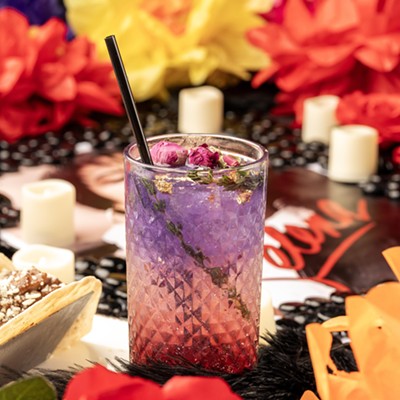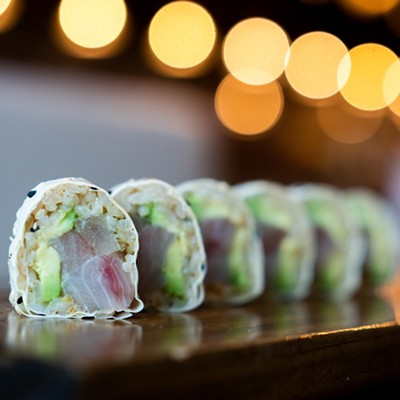Evidently, Houston has always been like that. Maybe not as a restaurant town, like it is today, but at least as a food town.
Harper’s – the fanciest of the fancy-pants New York mags -- has thrown open the entirety of its 158-year archives for subscribers, and I recently found an article on the subject written by one Lee Cohen Harby. She was quite taken with Houston’s food, not to mention the controlled chaos of a Saturday evening in Market Square and it’s multi-ethnic stewpot of blacks, Latins, Asians, white Americans, and various Europeans, all offering up foodstuffs and trinkets from their native lands.
While it sounds like a trip to the Bellaire Fiesta and the wholesale shops on Harwin Avenue, the thing is, Harby was describing the Houston of 1890.
And since she was writing in 1890, she seemed hell-bent on deploying a full arsenal of stereotypes and language calculated to offend every race other than whites, including epithets like “Dago” and “darky” and ill-advised attempts at Chinese and Italian dialectical English.
However, it should be kept in mind that Harby, as a Jewish woman, was probably no stranger to discrimination herself, and there are far worse example of racism in the Harper’s archives. In fact, you could argue that there was no racist intent behind the charged language Hamby used at all.
At any rate, after the jump you can be the judge of that and soak up what it was like to go grocery shopping in Victorian Houston. (And beware, this is a somewhat long post.)
Hamby writes:
“[The Saturday market] has borne good fruit, opening out great and new fields for trade, as the German farmers soon came in from distances of twenty miles and more, hauling their produce in wagons, and wholesaling it to the many small dealers, who now depend on this supply, their ‘prairie schooners’ and slow ox teams of four and five yokes of oxen filling the streets with an element usually unknown in city life.”
Hamby describes Houston’s old market-house as “a fine-looking building, with crouching lions at the corners and fountains in the grass-plot at the side” but added that it was the people that made it remarkable – “the venders alone representing every nationality, Americans being far in the minority.”
These venders [sic] included “negro market gardeners” offering up “fat turkeys, ready dressed or alive in coops” and “tiny birdpeppers, brilliant in hue, small as a pea, hot as fire, and delightful in flavor, which grow wild along the bayou that borders his land.” (These are also called pequin peppers and are seven times hotter than jalapeños.)
Nearby on the sidewalk was a Chinese peddler with his wares. “John has his pigtail neatly pinned up, and his blouse and shoes are models of cleanliness. ‘Anytling a day?’ he asks, exhibiting wonderful fans and cushions, brushes, teapots, Chinese lilies, and what not. He tries to be very persuasive in his pidgin-English, and resents demonstratively the interruption of the little black-eyed Dago boy who runs up his hand-cart of hot peanuts and takes his stand, vociferously calling his wares.”
Next to John, Hamby describes “a fat, yellow man, as greasy as his own plucked geese” who was arguing with a young girl about the price and weight of the okra she just bought “for gumbo on the morrow.”
Not far from this dispute stood “a little German woman, face sharp and puckered into innumerable wrinkles” offering up “balls of hand-cheese, strewed with caraway seeds, are white and appetizing: She has some put away in a can, which she tells you ‘schmeck güt’; but when uncovered they are as yellow as gold, and ‘smell to heaven’; yet these her German customers prefer.”
On to the totally organic, locally-produced wild game. A “thin-faced Italian” guarded a wagon laden with mule-eared rabbits, "mollie-cotton-tails,” squirrels ('red, black and gray’ some skinned, others not), partridges, (now-endangered) prairie-chickens, snipe, wild geese, ducks “of all kinds, from canvas-back to didapper”, and even a sandhill crane. “(F)ine eating the bird is too, and a handsome fellow to shoot.”
“The owner is a good salesman and an eager [sic]. He calls to each passer-by and knows well how to praise and show his stock,” Hamby writes. “Small, swarthy, lithe, and dirty, he is a type of his class, always asking higher than he will get, and dropping little by little to the offered price at last.”
Also inside the marketplace stood four rows of vegetable stalls, staffed exclusively by German and Irish women. “Their wares make a pretty show: no hot-bed products are here, no garden truck from other States, but all home-raised. The fresh green and white of the succulent spring vegetables are seen in the midst of December, the pale pink radishes lying in the crisp, curly leaves of chicory; the purple kohl-rabi against the piles of creamy wax beans; the long slim pods of ‘Carolina okra’ are heaped next to golden carrots and red spring beets; piles of purple eggplants are ranged between cabbage heads, proverbially hard; while great bunches of cool white celery keep company with baskets of fresh green pease and pink-skinned new potatoes.”
So much for the vegetables. The fruit was the exclusive province of men Hamby described thusly: “Here again the Dago comes to the fore,” Hamby wrote. “Very foreign they look, with gold rings in their ears, men though they be, and red mufflers around their throats.”
She segues into her best Chico Marx: “‘Lemona a tawenta centa dozna ; appelay, banan, grapa-all a cheepa,’ they assure one as he goes by.”
The Italians furnished “endless amusement” to the “respectable-looking colored man and woman opposite.” This couple were pioneers of the fast food business, their stall sounding almost like an ancestor to Frenchy’s. The fare: “Fried catfish and tender chicken, hard-boiled eggs and heaps of golden cornbread and roasted potatoes, with thin-sliced sandwiches, all appetizing indeed."
Hamby glossed over the meat market, save to describe the butchers as nearly all German save for “a Frenchman and an American or two, to mix the nationalities.” Next to the meat market stood a bazaar: “Little stores of ready-made clothing, both male and female, tin-ware, cutlery, baskets, fancy articles, candy, all separate, and the last-named stalls presided over by handsome Italian and pleasant German girls. It is a very olla podrida of merchandise.”
And of course there was seafood too: “Here once more does the Dago find an occupation. There are shrimps, crabs, oysters, and all sorts of fish, but the catfish, in infinite variety, stands out in marked prominence, for it is the favorite of the negro race, and they are rare good customers.”
Hamby was taken with the humanity of it all, the spectacle, the sexual tension.
“…(T)he fine ladies do not seem to mind the mixture of peoples or the place itself; but dress in ‘purple and fine linen’ for the occasion. The dude is in force, and the ‘masher’ is not wanting; the men who stare and the girls who love to be stared at; sober matrons on housekeeping thoughts intent; flirtatious maidens who push through the crowd, and seem to have no idea that their manners are not of the best; natty negro wenches, pert of tongue and loose of demeanor; respectable colored' 'maumas,’ ample of girth, in spotless white aprons; strapping negro men and saucy bootblacks; merchants, lawyers, and physicians; servant-girls and cooks; the haute-volée and the demimonde, and both in their best attire; policemen and tramps; old women, men on crutches, and babies in arms; black, white, brown, and yellow - negroes, Americans, Mongolians, Irish, Dutch, French, Germans, Italians, and Spanish - they are all there, laughing, talking, quarrelling, gesticulating, bargaining, gossiping, staring, keeping appointments and making new ones, being proper or improper, polite or rude, as the case may be."
All in all, she wrote, it was “a wonderful scene, a bustling, moving picture of contrast and characters, and helps the traveller to better understand the prosperity of [Texas], which attracts one, and its rudenesses, which repel.”
The more things change…
-- John Nova Lomax






